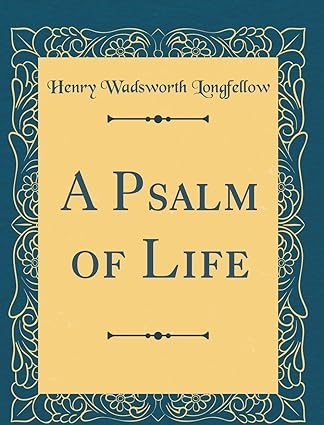A Psalm of Life
Henry W. Longfellow, whose full name is Henry Wadsworth Longfellow, was an American poet and educator born on February 27, 1807, in Portland, Maine, and died on March 24, 1882, in Cambridge, Massachusetts. He is one of the most famous and beloved poets of the 19th century in the United States.
Longfellow’s poetry often focused on themes of optimism, hope, and the human spirit’s capacity for perseverance in the face of challenges. He was known for his lyrical and accessible style, which made his poetry popular with a wide audience.
“A Psalm of Life” is one of Longfellow’s most well-known poems, published in 1838 as part of his collection titled “Voices of the Night.” The poem is a call to action, encouraging readers to live a purposeful and meaningful life. It rejects a passive and resigned approach to life, advocating instead for a proactive and hopeful attitude.
Summary of “A Psalm of Life”:
The poem begins with the speaker addressing the reader and urging them not to be like “the grave” that is dark and silent. The speaker emphasizes that life is fleeting and that it is essential to make the most of it. He advises against dwelling on the past or dreaming about the future but instead focusing on the present.
The central message of the poem can be summarized in the famous lines:
“Act,—act in the living Present!
Heart within, and God o’erhead!”
The speaker encourages readers to act with determination and purpose, to strive for noble and meaningful goals, and to leave a positive mark on the world. He believes that life is a battlefield where individuals must fight for their dreams and ideals.
The poem acknowledges that life can be challenging and that individuals will encounter obstacles and setbacks. Still, the speaker insists that one should remain undeterred and continue to pursue their goals with unwavering determination.
In the final stanza, the speaker emphasizes the importance of leaving a lasting legacy and being remembered for one’s contributions to society. He suggests that, in the end, the “Footprints on the sands of time” will endure, serving as a testament to a life well-lived.
Overall, “A Psalm of Life” is a motivational and inspirational poem that encourages readers to embrace life, live it to the fullest, and make a positive impact on the world. It rejects a passive and resigned attitude in favor of an active and hopeful approach to life’s challenges and opportunities.
Question and Answer
Does the title suggest what the poem is about?
Ans: Yes, the title suggests that the poem is about ‘life.’ The poet attempts to explain the real nature of life, its purpose, and the way to live it optimally.
What does the poet say about life in the first stanza?
Ans: In the first stanza, the poet expresses that life often appears like an empty dream, showing many colorful dreams, most of which remain unfulfilled.
What does the poet mean by, “Live in real! Life is earnest!”
Ans: The poet says “life is real! Life is earnest!” to counter the idea that life is an empty dream. He asserts that the goal of life is not death or the grave but to undertake noble actions and make a meaningful impact.
What is the poet’s observation on the ‘soul’?
Ans: The poet conveys that the physical body may die and return to dust, but the ‘soul’ remains immortal and cannot be destroyed by fire or water. Life is not about the body; it’s about the soul.
Quote the line that means “death is not the goal of life”?
Ans: “And the grave is not its goal.” This line asserts that death is not the ultimate purpose or goal of life.
What attitude does the poet challenge in the first two stanzas? Is the attitude of the poet positive or negative?
Ans: In the first two stanzas, the poet challenges the attitude of pessimistic individuals who view life as an empty dream. The poet’s attitude is positive because he emphasizes that “life is real” and urges us to live purposefully.
“Dust thou art, to dust thou returnest.” This expression alludes to the Bible. What are the other lines in the poem that make an allusion to the Bible?
Ans: Other allusions to the Bible include “our hearts like muffled drums, are beating funeral marches to the grave” and “In the world’s broad field of battle / In the bivouac of life / Be not like dumb, driven cattle.”
What does the poet say about the goal of life in stanza-3?
Ans: The poet highlights that the goal of life is not the grave, but rather to act in a way that each tomorrow finds us farther ahead than today.
What is the poet’s observation on “Art”?
Ans: The poet observes that Art is enduring; it stands the test of time. Time cannot destroy ‘art,’ and it continues to exist even after the death of the artist.
“Be a hero in the strife”- Is it an inspiring call of the poet? What other things does the poet urge us to do?
Ans: Yes, it is an inspiring call from the poet. The poet encourages us to be proactive and courageous in facing life’s challenges. He also urges us to leave a lasting mark on the world and to strive for greatness.
Why does the poet prefer the ‘present’ to ‘past’ and ‘Future’?
Ans: The poet suggests that the future is uncertain and the past is already gone, but the present is in our hands. He advocates for making the best use of the present moment.
What do the lives of great men remind us of?
Ans: The lives of great men remind us that we can make our lives sublime by engaging in honest labor and dedicating our lives for the betterment of mankind.
How do the examples of great men help a person in distress?
Ans: When a person is in distress, the examples of great men provide encouragement, hope, and a sense of direction. They inspire one to persevere through difficult times.
How can we make our life sublime?
Ans: We can make our life sublime by being proactive and industrious, keeping our hearts ready for any fate, learning from experiences, achieving and pursuing more.
Do you find each stanza has four lines rhyming alternately at the end and each stanza has a recurrent rhythm pattern- 8 syllables, 7 syllables, 8 syllables, 7 syllables. What is the rhyme scheme of the poem?
Ans: The rhyme pattern of the poem is ABAB, where the first and third lines of each stanza rhyme, and the second and fourth lines rhyme.
The poet uses depressing words like ‘mournful’, ’empty’, ‘dead’, ‘grave’. What other such words does he use in the poem?
Ans: Other such words in the poem include “muffled drums,” “funeral marches,” “departing,” “shipwrecked brother,” “forlorn,” etc.
What is the tone of the poet – inspiring or despairing?
Ans: The tone of the poem is inspiring, as it emphasizes the true purpose of life and encourages proactive and purposeful living.
What other similes do you find in the poem?
Ans: Another simile in the poem is, “Be not like dumb, driven cattle.”
“Life is but an empty dream” – what figure of speech is used here? Quote another line of the same stanza in which this figure of speech is used?
Ans: The figure of speech used here is a simile. Another comparison in the same stanza is, “And things are not what they seem.”
Additional question and Answer
What is the central message of “A Psalm of Life”?
Ans: The central message of the poem is to encourage people to live actively and purposefully, making the most of their present moments, rather than dwelling on the past or worrying about the future.
What is the significance of the poem’s title, “A Psalm of Life”?
Ans: The title suggests that the poem conveys a message akin to a psalm or sacred song, offering guidance on how to live a meaningful and purposeful life.
What is the poet’s opinion about life being “an empty dream”?
Ans: The poet disagrees with the notion that life is an empty dream. He believes that life is real and meaningful, and it should be lived with purpose and vigor.
Explain the line, “Footprints on the sands of time.”
Ans: This line suggests that our actions and deeds in life leave an impression or mark, like footprints in the sand, which can inspire and guide others.
What is the poet’s view on the immortality of the soul?
Ans: The poet asserts that the soul is immortal, and even though the physical body may perish, the soul continues to exist. It cannot be destroyed by external forces.
How does the poet describe the concept of “Art” in the poem?
Ans: The poet describes “Art” as enduring and long-lasting. He believes that artistic creations, like great works of literature, continue to exist and inspire, transcending time.
What does the poet mean by “Be a hero in the strife”?
Ans: The poet urges readers to exhibit courage and determination when facing life’s challenges and difficulties. He encourages them to be heroes in the battles of life.
What role do “lives of great men” play in the poem’s message?
Ans: The lives of great men serve as examples and inspirations. They remind us that by living purposefully and accomplishing noble deeds, we too can leave a lasting legacy.
Why does the poet emphasize the importance of the present moment in life?
Ans: The poet emphasizes the present because it is the only time we have control over. He believes that making the most of the present can shape a meaningful future.
What is the significance of the line, “Art is long, and Time is fleeting”?
Ans: This line highlights the enduring nature of artistic creations and the fleeting nature of time. It underscores the idea that our actions and creations can outlast our lifetimes.
Why does the poet compare life to “a field of battle”?
Ans: The poet uses this comparison to emphasize that life is full of challenges and struggles, and individuals should approach it with courage and determination.
What is the poet’s advice on dealing with adversity and setbacks in life?
Ans: The poet advises not to be disheartened by adversity or setbacks. Instead, one should view them as opportunities to learn and grow, continuing to strive for success.
What does the poet mean by “Act—act in the living Present!”?
Ans: The poet means that individuals should take action and make the most of the present moment rather than procrastinating or dwelling on the past.
What figure of speech is employed in the line, “Let us then be up and doing”?
Ans: The figure of speech used here is a metonymy, where “up and doing” represents being active and productive.
What is the poem’s message regarding the inevitability of death?
Ans: While the poem acknowledges the inevitability of death, it encourages readers not to focus on death but to live life to the fullest and leave a positive impact.
How does the poet view the idea of “mournful numbers”?
Ans: The poet views “mournful numbers” as those who are pessimistic and mourn the challenges of life. He encourages people to adopt a more positive and proactive attitude.
What does the poet mean by “Leave no black plume as a token of that lie”?
Ans: The poet means that individuals should not leave behind symbols of their negativity or pessimism. Instead, they should strive to make a positive impact on others.
How does the poem emphasize the idea of individual agency and responsibility in shaping one’s life?
Ans: The poem emphasizes that individuals have the power to shape their lives through their actions, choices, and attitudes. It encourages taking responsibility for one’s life.
What is the poet’s view on the impact of a purposeful life on others?
Ans: The poet believes that living a purposeful and meaningful life can inspire and uplift others, leaving a positive and lasting impression on the world.
In what ways can readers apply the message of “A Psalm of Life” to their own lives?
Ans: Readers can apply the poem’s message by living purposefully, being courageous in the face of challenges, valuing the present moment, and striving to leave a positive legacy through their actions and deeds.
We sincerely appreciate your time and interest in our content A Psalm of Life. Your support means the world to us, and we’re thrilled that you chose to visit our page.
At AskXYZ, we’re committed to delivering valuable and engaging content. We want to ensure that your experience with us is exceptional. That’s why we invite you to explore more of our posts/articles. We’re confident you’ll find something that piques your interest.
Your feedback is incredibly important to us. It helps us understand what you love and how we can improve. Please take a moment to share your thoughts or suggestions. We’re all ears!
Explore our other posts/articles and share your feedback with us .






